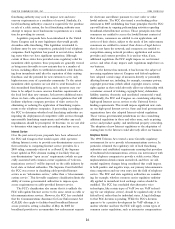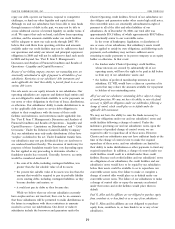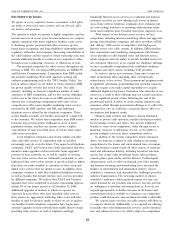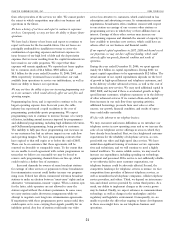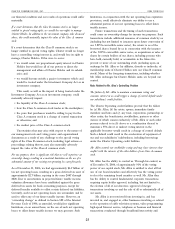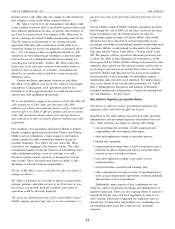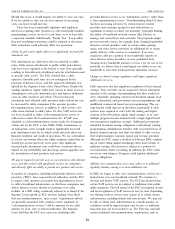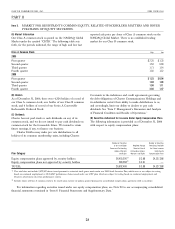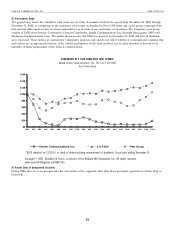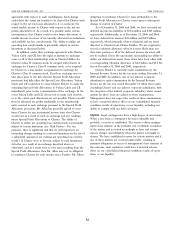Charter 2006 Annual Report Download - page 40
Download and view the complete annual report
Please find page 40 of the 2006 Charter annual report below. You can navigate through the pages in the report by either clicking on the pages listed below, or by using the keyword search tool below to find specific information within the annual report.
CHARTER COMMUNICATIONS, INC. 2006 FORM 10-K
Should this occur, it would impede our ability to raise our rates. provided Internet service as an ‘‘information service,’’ rather than
If we are unable to raise our rates in response to increasing a ‘‘telecommunications service.’’ Notwithstanding Brand X, there
costs, our losses would increase. has been increasing advocacy by certain internet content
There has been considerable legislative and regulatory providers and consumer groups for new federal laws or
interest in requiring cable operators to offer historically bundled regulations to adopt so-called ‘‘net neutrality’’ principles limiting
programming services on an ´a la carte basis, or to at least offer the ability of broadband network owners (like Charter) to
a separately available child-friendly ‘‘Family Tier.’’ It is possible manage and control their own networks. The proposals might
that new marketing restrictions could be adopted in the future. prevent network owners, for example, from charging bandwidth
Such restrictions could adversely affect our operations. intensive content providers, such as certain online gaming,
music, and video service providers, an additional fee to ensure
Actions by pole owners might subject us to significantly increased pole quality delivery of the services to consumers. If we were
attachment costs. required to allocate a portion of our bandwidth capacity to
other Internet service providers, or were prohibited from
Pole attachments are cable wires that are attached to utility charging heavy bandwidth intensive services a fee for use of our
poles. Cable system attachments to public utility poles histori- networks, we believe that it could impair our ability to use our
cally have been regulated at the federal or state level, generally bandwidth in ways that would generate maximum revenues.
resulting in favorable pole attachment rates for attachments used
to provide cable service. The FCC clarified that a cable Changes in channel carriage regulations could impose significant
operator’s favorable pole rates are not endangered by the additional costs on us.
provision of Internet access, and that approach ultimately was
upheld by the Supreme Court of the United States. Despite the Cable operators also face significant regulation of their channel
existing regulatory regime, utility pole owners in many areas are carriage. They currently can be required to devote substantial
attempting to raise pole attachment fees and impose additional capacity to the carriage of programming that they would not
costs on cable operators and others. The favorable pole carry voluntarily, including certain local broadcast signals, local
attachment rates afforded cable operators under federal law can public, educational, and government access programming, and
be increased by utility companies if the operator provides unaffiliated commercial leased access programming. This car-
telecommunications services, in addition to cable service, over riage burden could increase in the future, particularly if cable
cable wires attached to utility poles. To date, VoIP service has systems were required to carry both the analog and digital
not been classified as either a telecommunications service or versions of local broadcast signals (dual carriage), or to carry
cable service under the Communications Act. If VoIP were multiple program streams included with a single digital broad-
classified as a telecommunications service under the Communi- cast transmission (multicast carriage). Additional government-
cations Act by the FCC, a state Public Utility Commission, or mandated broadcast carriage obligations could disrupt existing
an appropriate court, it might result in significantly increased programming commitments, interfere with our preferred use of
pole attachment costs for us, which could adversely affect our limited channel capacity, and limit our ability to offer services
financial condition and results of operations. We are a defendant that would maximize customer appeal and revenue potential.
in at least one lawsuit where the utility company claims that we Although the FCC issued a decision in February 2005, confirm-
should pay an increased rate on its poles. Any significant ing an earlier ruling against mandating either dual carriage or
increased pole attachment costs could have a material adverse multicast carriage, that decision is subject to a petition for
impact on our profitability and discourage system upgrades and reconsideration which is pending. In addition, the FCC could
the introduction of new products and services. reverse its own ruling or Congress could legislate additional
carriage obligations.
We may be required to provide access to our networks to other Internet
service providers which could significantly increase our competition Offering voice communications service may subject us to additional
and adversely affect our ability to provide new products and services. regulatory burdens, causing us to incur additional costs.
A number of companies, including independent Internet service In 2002, we began to offer voice communications services on a
providers (‘‘ISPs’’), have requested local authorities and the FCC limited basis over our broadband network. We continue to
to require cable operators to provide non-discriminatory access develop and deploy VoIP services. The FCC has declared that
to cable’s broadband infrastructure, so that these companies may certain VoIP services are not subject to traditional state public
deliver Internet services directly to customers over cable utility regulation. The full extent of the FCC preemption of state
facilities. In a 2005 ruling, commonly referred to as Brand X, the and local regulation of VoIP services is not yet clear. Expanding
Supreme Court upheld an FCC decision making it less likely our offering of these services may require us to obtain certain
that any nondiscriminatory ‘‘open access’’ requirements (which authorizations, including federal and state licenses. We may not
are generally associated with common carrier regulation of be able to obtain such authorizations in a timely manner, or
‘‘telecommunications services’’) will be imposed on the cable conditions could be imposed upon such licenses or authoriza-
industry by local, state or federal authorities. The Supreme tions that may not be favorable to us. The FCC has extended
Court held that the FCC was correct in classifying cable certain traditional telecommunications requirements, such as
26


